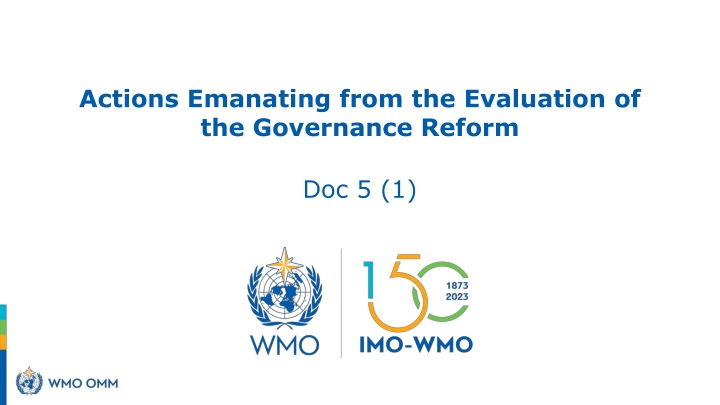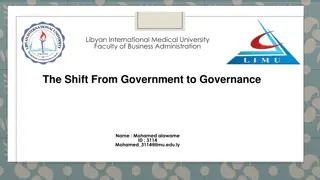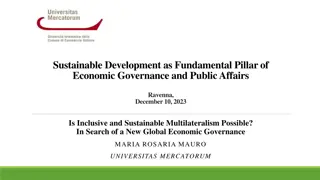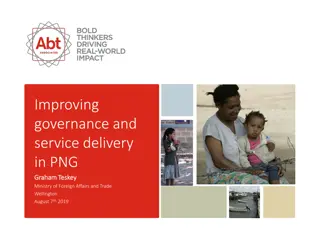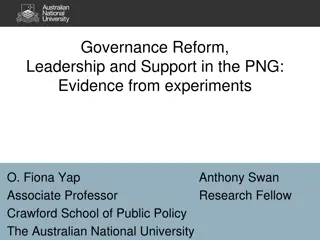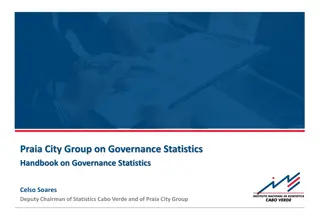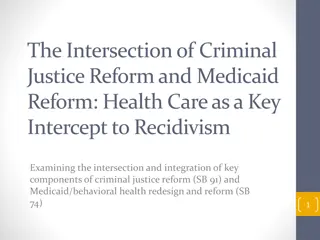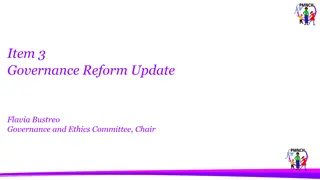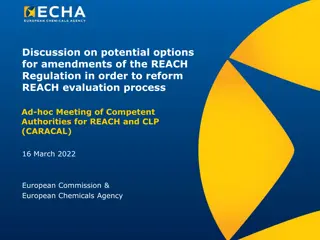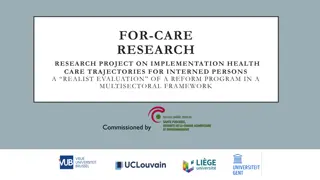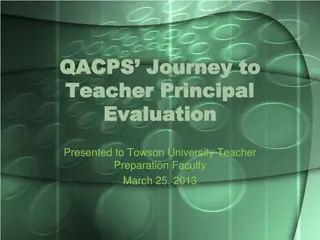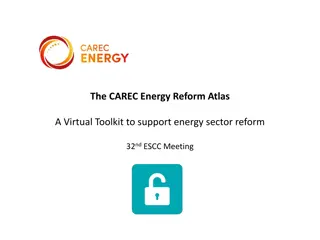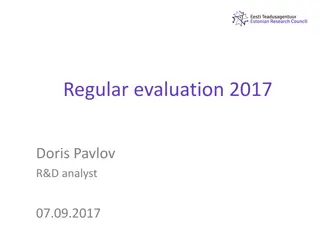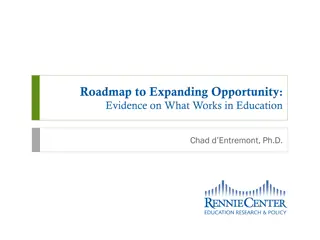Actions Emanating from the Evaluation of the Governance Reform
The evaluation of the governance reform within the WMO aimed to assess its alignment with strategic objectives, effectiveness in responding to societal needs, coordination efficiency, decision-making process, agility, and more. Evaluation criteria included relevance, design validity, effectiveness, resource efficiency, impact orientation, gender, and regional balance. The process involved a task force overseeing the evaluation, competitive bidding for an evaluation team, and multiple meetings to review findings and make recommendations. The methodology included documentary reviews, stakeholder surveys, interviews, and focus groups. The evaluation highlighted successful areas despite challenges faced during implementation due to the COVID-19 pandemic.
Download Presentation

Please find below an Image/Link to download the presentation.
The content on the website is provided AS IS for your information and personal use only. It may not be sold, licensed, or shared on other websites without obtaining consent from the author.If you encounter any issues during the download, it is possible that the publisher has removed the file from their server.
You are allowed to download the files provided on this website for personal or commercial use, subject to the condition that they are used lawfully. All files are the property of their respective owners.
The content on the website is provided AS IS for your information and personal use only. It may not be sold, licensed, or shared on other websites without obtaining consent from the author.
E N D
Presentation Transcript
Actions Emanating from the Evaluation of the Governance Reform Doc 5 (1)
Evaluation Objectives 1 Compare with previous arrangements whether the constituent body reform has resulted in: Better alignment with the WMO Strategic Plan An increased effectiveness in responding to societal needs Better engagement of Members, experts and partners Efficiencies, synergies and enhanced coordination among all parties A more effective decision-making process A more agile organization 2 Assess the effectiveness and efficiency of the reform process 3 Identify any barriers or constraints and provide recommendations accordingly
Evaluation Criteria 1. Relevance, coherence and strategic fit of the new governance structure 2. Validity of its design 3. Effectiveness of the governance functioning and improved coordination among the constituent bodies 4. Efficiency of resources use 5. Impact orientation and sustainability 6. Gender and regional balance
Process and Oversight EC Task Force on Reform Evaluation: established by EC-74 (Decision 5) to oversee the evaluation Secretariat: organized competitive bidding and engaged an evaluation team (EY) EC-76: reviewed, updated & endorsed the TF-RE recommenda tions Policy Advisory Committee: endorsed Terms of Reference EC-73: requested an external evaluation (Decision 4) Chaired by the President 7 more members from all regions 5 meetings In-depth review of the evaluation findings and recommendations Consolidated recommendations to EC
Evaluation Methodology Documentary review: supplemented by monitoring indicators Direct observation: a sample of governance meetings A stakeholder survey: Members Partners Secretariat Interviews: Members, incl. Presidents of Regional Associations Governance members, incl. Presidents of Technical Commissions, members of Standing Committees, Chair and members of the Research Board, members of the Scientific Advisory Panel External Partners Secretariat Focus groups: e.g. with members of management groups and standing committees
Main Findings: Areas of Success INF. 5(1a) Report of the External Evaluation of the WMO Governance Reform Reform assessed as largely successful in reaching its objectives, regardless of the challenging times in which it has been implemented due to the COVID-19 pandemic A WMO better equipped to respond to the needs of the external environment New structure coherent with the Strategic Plan, more appropriate in addressing cross- cutting themes Reduction in the number of TCs enabled WMO to fulfil its core tasks in a more streamlined manner without the existence of numerous silos Major causes of historical inefficiencies in the conduct of business: largely addressed Cost savings observed, though some were directly linked to the COVID-19 pandemic.
Main Findings: COVID-19 Impacts Positive Improved working methods Better documentation Extensive use of videoconferencing enabled greater presence of experts and greater participation of PRs in meetings increased visibility of WMO activities to NMHS and national institutions Negative Decreased participation of experts from certain time zones and countries with low connectivity Certain level of disengagement Limited time for debate Inability to build relationships and create links
Main Findings: Areas for Improvement No major issue or a fundamental limitation to the governance approach observed Room for improvement in terms of: Coordination and cooperation (creating greater synergies with RAs) Improved clarity to the mandate of specific bodies (RB, SAP, TCC, HCP) Improved clarity to the functions of particular officers (e.g. TC vice presidents) Participation in the new bodies and integration of expertise in their structures Continued imbalance in regional representation Further engagement of partners Strengthened communication on results of the reform and WMO s contribution to SDGs
Consolidated Recommendations INF. 5(1b) Consolidated Analysis of Evaluation Recommendations by the Executive Council Task force on Reform Evaluation (TF-RE) and Policy Advisory Committee (PAC) EC-76 External evaluators TF-RE: PAC: Recommendation 6(1)/1 (EC-76) An initial set of recommendations Further elaborated and re- grouped based on detailed analysis of feasibility and urgency Reviewed and endorsed the TF-RE recommendations Doc. 5(1) INF. 5(1b) INF. 5(1a)
For Congress Action Draft Resolution 5(1)/1 (Cg-19) Adopt: Proposed amendments to TORs of Research Board (draft Resolution 4.3(3) (Cg-19)) Request: SAP: to review and recommend amendments to EC JCB: to conduct a self-assessment, review TORs, recommend amendments to EC Invite IOC-UNESCO to consider amendments to JCB Request EC to: Oversee implementation of the recommended actions Commission an external evaluation of the effectiveness of WMO governance ahead of Cg-20 Recommend further improvements to methods of work and procedures (new USA); Invites TCs, RB and RAs toconsider EC recommendations and seek improvements (rules of procedure, coordination mechanisms, working practices) Request Secretary-General to monitor and report on indicators on the effective and efficient functioning of WMO governance
For EC action Policy Advisory Committee: maintain with revised TOR Technical Coordination Committee: consider replacing with a more informal Technical Coordination Group Coordination panels (HCP, EC-PHORS, CDP): review TORs and propose amendments Climate Coordination Panel: retire in recognition of fulfilled mandate; keep Climate Policy Advisors Group as an entity reporting to PAC, with updated TORs Guiding principles for the organization of face-to-face and virtual sessions: approved by EC-76 An external evaluation of the effectiveness and efficiency of WMO bodies and structures: commission ahead of Cg-20
For TC and RA action Periodic review of subsidiary bodies and enhancements to coordination practices and mechanisms Definition of the duties of the co-vice presidents + provisions for better expertise and regional balance of officers for inclusion in the Rules of Procedure Enhancements to the planning tools and process for better coordination and alignment of work programmes Improvement in engagement of experts nominated in the Expert Network for better regional and gender balance (see Doc. 4.5(2)) Actions on the retainment and engagement of experts, including young professionals Improvements to the nomination process for experts (strengthened role of RAs/ROs)
For SG Action A common template based on the Operating Plan for harmonized planning of the work of constituent and other bodies Communication of the results and benefits of the reform to Members Reports and regular communication on WMO contribution to the SDGs Continued monitoring of indicators related to the effective and efficient functioning of governance bodies.
